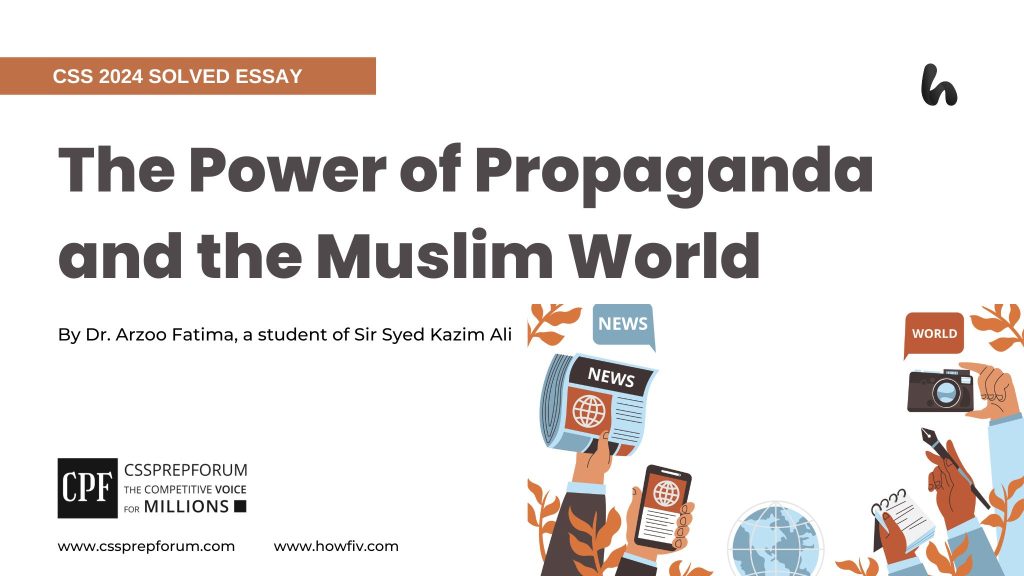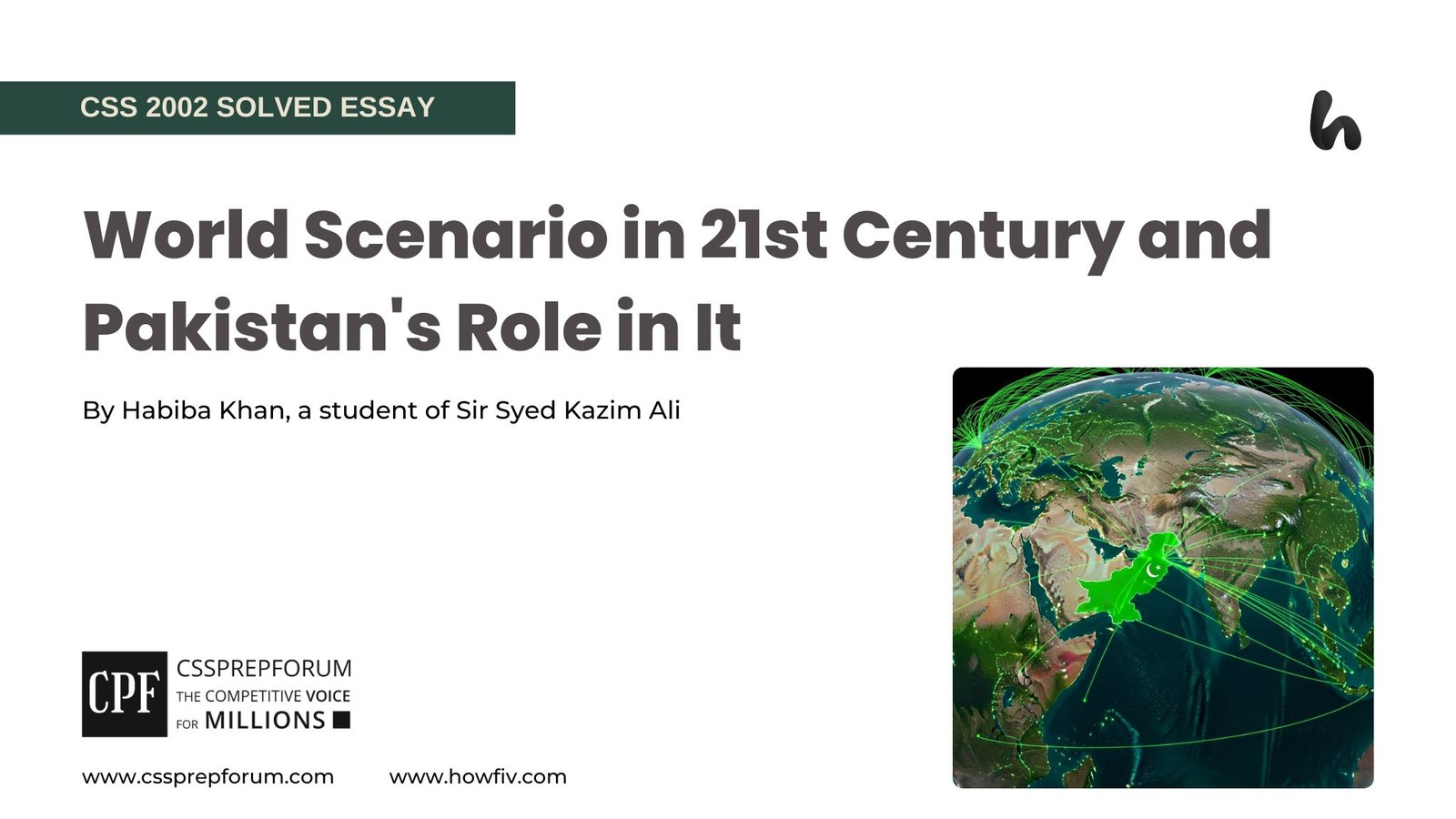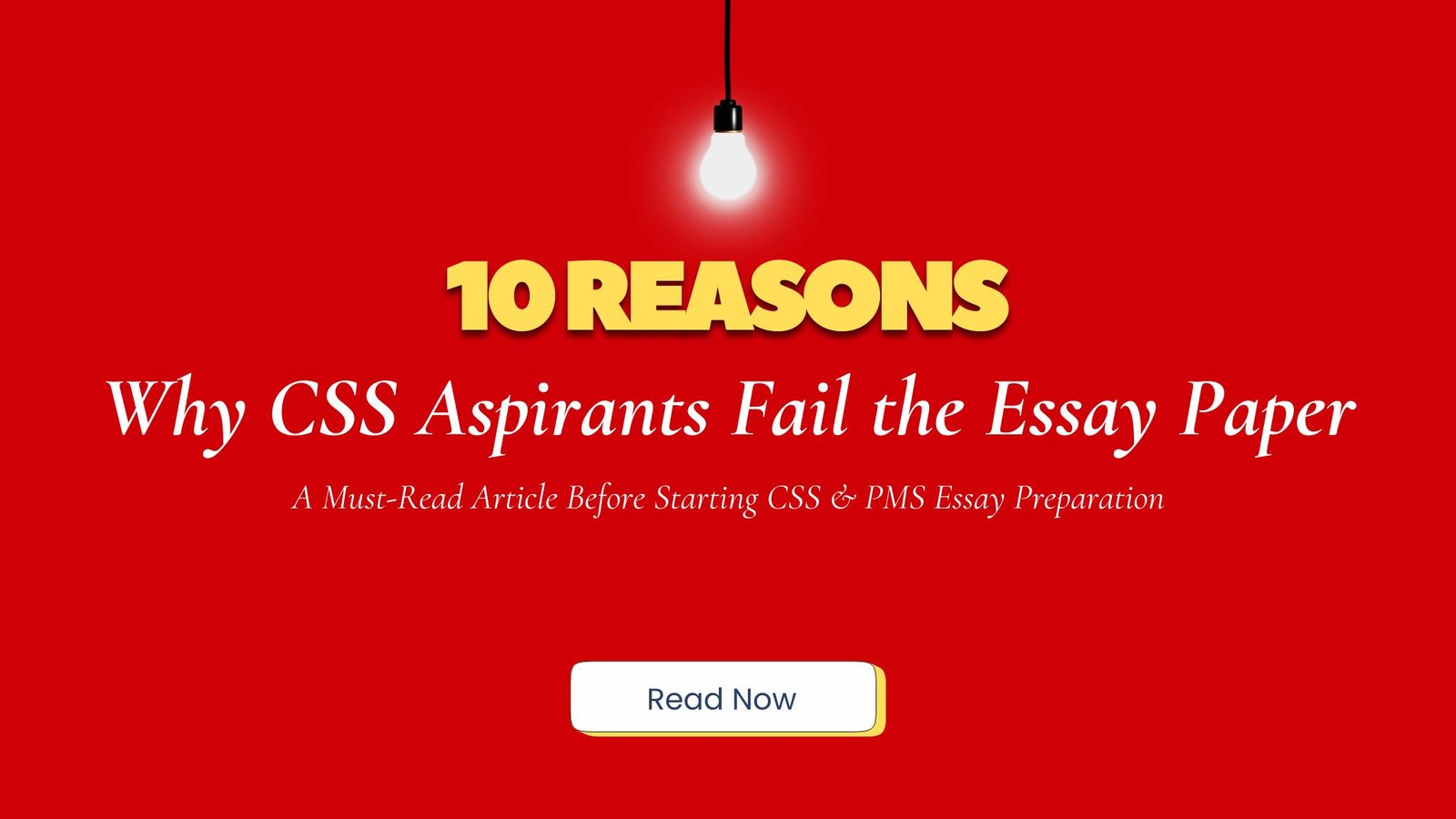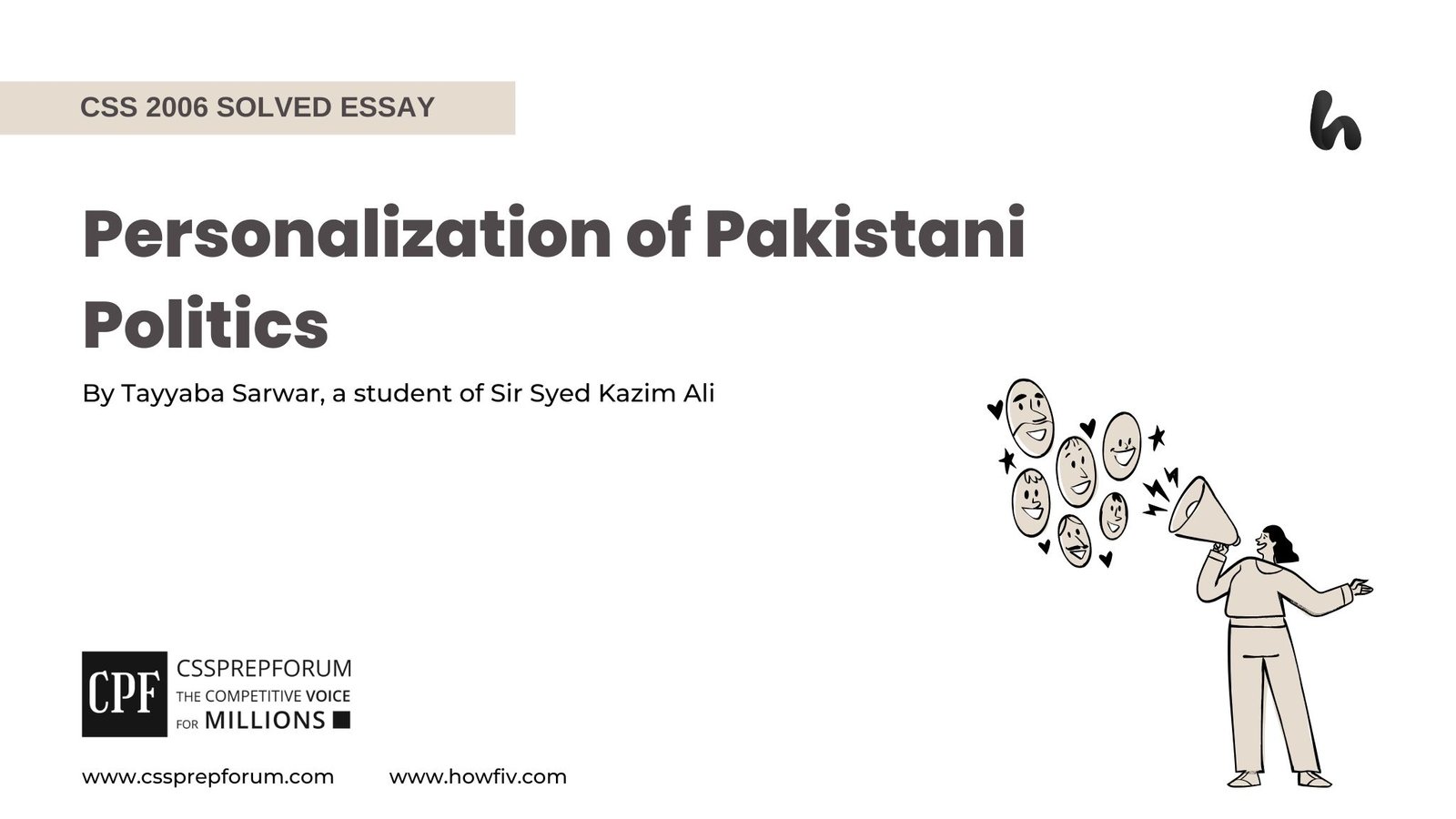CSS 2024 Solved Essay | The Power of Propaganda and the Muslim World
Dr. Arzoo Fatima, a Sir Syed Kazim Ali student, has attempted the CSS 2024 Solved Essay “The Power of Propaganda and the Muslim World” on the given pattern, which Sir Syed Kazim Ali teaches his students. Sir Syed Kazim Ali has been Pakistan’s top English writing and CSS, PMS essay and precis coach with the highest success rate of his students. The essay is uploaded to help other competitive aspirants learn and practice essay writing techniques and patterns to qualify for the essay paper.

Outline
1-Introduction
The power of propaganda through strategic control of global media, political institutions, and economic affairs by the West has persistently depicted Muslims as inherently violent and backwards, influencing global perceptions, shaping social, political and cultural dynamics, and fueling the continuation of prejudiced stereotypes, necessitating a critical analysis of its origins, methods, and consequences.
2-Historical Context of Propaganda in the Muslim World
- ✓Early use of propaganda in Islamic history
- ✓Colonial and post-colonial periods
- ✓Propaganda during major conflicts (e.g., Arab-Israeli conflict, Gulf Wars)
3-What are the means of persuasion through propaganda?
- ✓Traditional media (newspapers, radio, television)
- ✓Digital and social media platforms
- ✓Educational and religious institutions
4-How has the power of propaganda by the West impacted the Muslim world?
4.1-Political Impacts
- ✓Argument: The emergence of the political rift between Eastern and Western nations on the global stage
- Evidence: According to the book “Islam and the West: The Politics of Phobia” by Mehmet Staley, The US administration’s populist tendencies fueling anti-Muslim sentiments, resulting in a rift between Eastern and Western nations since 9/11
- ✓Argument: The rise of disenchantment against Muslims by counterfeit laws and policies
- Evidence: The Global Attitudes Project revealed that the U.S. government fostering disillusionment through fabricated laws and policies that unfairly target Muslims with inclinations towards the Islamic State of Syria (ISIS)
- ✓Argument: The surge of radicalism in Muslim nations posing a threat to democratic values
- Evidence: According to the Intelligence Agency’s Report, “The West aiming to sway public perception in the war on terror by portraying the fearful image of violent terrorists, thus undermining democratic values and insinuating that the Muslim world provides a safe haven”
4.2-Social impacts
- ✓Argument: Social marginalization leading to persecution of Muslims in Western communities
- Evidence: According to the International Human Rights Bureau Report, the Muslims in western Myanmar, particularly the Rohingya Muslims, socially marginalized through persecution
- ✓Argument: Departure of Muslim youth away from the pristine teachings of Islam
- Evidence: According to the Pew Research Centre, “Western influence encouraging Muslim youth to astray from Islamic principles and embrace Western education and knowledge in order to transform their society and combat ignorance, illiteracy, and scientific underdevelopment”
- ✓Argument: The rise in misinterpretation of Islam and Muslims leads to increase foreign interference
- Evidence: According to “The Fear of Muslim” by Bravo Lopez, this book dealing with a controversial phenomenon known as Islamphobia: antipathy towards Islam, and leading to increase foreign interference
4.3-Cultural Impacts
- Argument: Cultural assimilation and loss of identity
- Evidence: In the book “The Islamic Threat: Myth or Reality” by John L. Esposito, Muslim communities balancing their fears of cultural assimilation and loss of identity as Western communities promoting ethnic minorities, like Jews
- ✓Argument: Dividing the Muslim world on the basis of ethnic and regional bases
- Evidence: According to the book “Cross-cultural adaptation: An integrative theory” by R. Wiseman, highlighting that the Western influence in the Muslim world largely based on ethnic and regional affiliations, particularly reflecting the divide between Sunni and Shia sects
- ✓Argument: Increase in propensity towards clash of civilizations
- Evidence: According to the Foreign Affairs piece titled “The Clash of Civilization”, by Samuel Huntington arguing about “Islamic threat” which was a triple threat to the West: political, civilizational and demographic realms
5-What can be the implications if the power of propaganda is used against the Muslim world?
- ✓Argument: Western propaganda could surge in civil war
- Evidence: According to the International Report on Civil and Political Rights, propaganda is believed to have the ability to outbreak the deadliest conflict, leading to civil war and approximately uprooting 48 million people at a time
- ✓Argument: Escalating threat to national security
- Evidence: The fate of the Muslim world would be similar to the Iraq war, which caused it to threaten national security.
6-What are the possible measures to counter the power of propaganda against the Muslim world?
- ✓To present the true image of Islam through media by forming channels like Al-Jazeera
- ✓To remove the sectarian barriers between the Muslim countries and unite on one platform
- ✓To work on the capacity building of countries, and restrict undue interference of western nations
- ✓To avoid the support for terrorism and extremism and focus on economic growth
7-Critical analysis
8-Conclusion

In an age characterized by the relentless transnational flow of information, the influence of propaganda stands as a force of undeniable significance. Of particular note is the profound impact of Western propaganda on the global perception of the Muslim world. Throughout historical colonial eras to the present digital milieu, Western narratives have persistently portrayed the Muslim world through a prism of conflict, stagnation, and extremism. These depictions are not merely incidental but rather integral components of a purposeful strategy designed to mould worldwide public opinion and legitimize geopolitical agendas. The repercussions of such propaganda are extensive, permeating political dynamics, cultural identities, and social interactions. Upon delving into this multifaceted issue, it becomes readily discernible that Western propaganda has markedly influenced the Muslim world by forging adverse stereotypes, swaying political dynamics, and heightening cultural and religious animosities. Consequently, it becomes imperative to meticulously scrutinize its genesis, methodologies, and ramifications to fully comprehend its profound implications and cultivate a more equitable and enlightened global dialogue.
To begin with, in the early centuries of Islamic history, propaganda was employed as a tool by various political and religious factions to advance their agendas and legitimize their authority. One of the earliest instances included disputes between the Sunni and Shia employed by propaganda. The Umayyad and Abbasid also promoted narratives that justified their political supremacy based on lineage and religious piety. Nevertheless, during the colonial period, European powers like Britain and France used propaganda to assert control over Muslim territories, promoting Western imperialism for the exploitation of Indigenous cultures and the extraction of natural resources to benefit imperial economies, so-called gunpowder empires. In the post-colonial era, propaganda refers to the struggles of indigenous peoples used to build national identities and consolidate political power with state-controlled media by the UN. Major conflicts, such as the Arab-Israeli conflict and the Gulf Wars, further amplified the use of propaganda. Both sides in these conflicts used media to garner international support and demonize opponents while Western and regional powers leveraged modern media to shape global perceptions and justify military actions. This historical context underscores propaganda’s enduring and evolving role in the Muslim world. In the words of the German sociologist Maxi,
“Propaganda is a slow boring of hard boards.”
Before moving ahead towards the main maxim, it is essential to understand the means of persuasion through propaganda. It has played a part in disseminating misleading information by employing effective techniques through traditional media, digital and social media platforms, and educational and religious institutions. Meanwhile, traditional media, including newspapers, radio, and television, shape publicopinion by strategically presenting news and incorporation emotional language and imagery.Editorials and biased reporting further influence readers and viewers by presenting one-sided perspectives. Later, the radio demonstrated a larger flow of information than many people realize. Nevertheless, digital and social media platforms amplify media persuasion and highlight algorithms that create eco-chambers. The rapid dissemination of viral content, memes, and influencer endorsements effectively conveys messages whereas bots and disinformation campaigns can influence perceptions on a broader level. Likewise, educational institutions shape the thinking of young individuals by incorporating specific ideologies into their curricula. Lastly, religious institutions also influence beliefs and values by delivering sermons and providing teachings. These methods collectively penetrate society, moulding opinions and behaviours across various demographics and highlighting the political, cultural, and economic impact that influences how propaganda is constructed and circulated in public discourse.
Moving further, a prominent argument that justifies the power of Western propaganda has politically impacted the Muslim world. The emergence of the political rift between the East and the West depicted Muslims as inherently violent. According to the book “Islam and the West: The Politics of Phobia” by Mehmet Staley, “The US administration’s populist tendencies have fueled anti-Muslim sentiments, resulting in a rift between Eastern and Western nations since 9/11.” This highlighted thatpropaganda was fueling an echo chamber effect against Muslims when the Bush administration accused Al-Qaeda of orchestrating the largest terrorist attacks. Consequently, it was inevitable that Pakistan, due to its historical connections with the Taliban, would become a key player in the US-led campaign and be accused of providing free land to Al-Qaeda. As a result, the US imposed sanctions and cut off diplomatic ties. Hence, this creates a political schism between Eastern and Western communities.
Moreover, Muslim countries are experiencing increasing disenchantment in Western societies due to counterfeit laws and policies. Islam has been denounced as a false religion due to the increasing influence of the West. According to the Global Attitudes Project Report, the United States government is fostering disillusionment through fabricated laws and policies that unfairly target Muslims with inclinations towards the Islamic State of Syria (ISIS). This highlighted that the Syrian war protracted international propaganda, leading up to the ban on Muslim freedom and religious symbols. The West established a dominant political campaign in Syria and the Middle East that portrays Muslims as a threat to society by portraying foreign fighters affiliated with ISIS, which surged terrorist attacks in the West. Hence, this creates disillusionment in the Muslim world around the globe.
Furthermore, the surge of radicalism in Muslim nations by the West poses a threat to democratic values. Indeed, the persistent depiction of Muslims as inherently violent has massively contributed to the “Propaganda battle”. According to the Intelligence Agency’s Report, “The West is aiming to sway public perception in the war on terror by portraying the fearful image of violent terrorists, thus undermining democracy and insinuating that the Muslim world provides a safe haven.” That means the West has changed the global image of the Muslim world by highlighting terrorist activity in the war on terror, and the ongoing legal measures pose a challenge to their government’s set norms and hinder the evolution of democracy. Hence, propaganda by the West has portrayed the Muslim world as violent and set the stage for internal conflicts.
Additionally, propaganda has affected the Muslim world socially by marginalizing Muslims in Western communities. The rising population of Rohingya Muslims has raised a pressing concern for Western Myanmar, and they have started mass detention of Rohingya and labelled them as “open prisons without end.” The International Human Rights Bureau Report indicates that the Muslims in the western part of Myanmar, especially the Rohingya Muslims, have been segregated socially through persecution. This report indicates that the Rohingya Muslims in Myanmar have faced repression for so long that it has resulted in mass displacement. A massive propaganda appeared to kvetch the Rohingya as illegal immigrants from Bangladesh and described them as terrorists to justify discriminatory practices and violence against them. Therefore, the Rohingya crisis has acted to marginalize and persecute the Rohingya community massively.
Apart from advancing societies,the Western propaganda has impacted the Muslim world by leading youth astray from the pristine teachings of Islam. The exchange of disseminated information has been possible through propaganda; for example,globalization has promoted Western societies, frequently advocating secularism and liberal values, which may conflict with Islamic beliefs. Young Muslims, who encounter these values through media and online platforms, often reevaluate their religious beliefs in the context of Western viewpoints. According to the Pew Research Centre, “Western influence is encouraging Muslim youth to astray from Islamic principles and embrace Western education and knowledge to transform their society and combat ignorance, illiteracy, and scientific underdevelopment.” Subsequently, the interconnectedness of communities can erode traditional religious practices among young Muslims, who are exposed to diverse viewpoints and influences.
Furthermore, the rise in misinterpretation of Islam and Muslims within Western communities is becoming more prevalent, which can influence international diplomacy. For instance, the tragic 9/11 incident has been fueled by the emergence of numerous terrorist groups. The Western media should address Muslims as “extremist,” “terrorist,” and “violent,” as a replacement for “slave traders,” “primitive,” and “ignorant.” According to “The Fear of Muslims” by Bravo Lopez, this book deals with a controversial phenomenon known as Islamophobia – antipathy towards Islam, which is ultimately long-standing from many quarters. This highlighted that the West’s misconceptions of Islam are not only fueled by ignorance and prejudices but also cultivated by some subtle red flags of the incompatibility of Islam. Hence, there has been a growing prevalence of misunderstandings regarding Islam and Muslims within Western societies.
Moving ahead towards cultural assimilation and loss of identity during the Gaza War, Western media’s slanted portrayal of the war, which frequently portrays Israel in a favourable while portraying Palestinians as aggressors, demonstrates the skewed nature of propaganda. In the book “The Islamic Threat: Myth or Reality” by John L. Esposito, “Muslim communities balance their fears of cultural assimilation and loss of identity as Western communities promote ethnic minorities, like Jews, by opening a window on the multidimensional realm called cultural ecology.” It underscores that cultural erasure resulting from assimilation is the history of Palestine forced assimilation in the Arab States. In the late, the US implemented a policy to “civilize” Native Palestinians by erasing their culture, beliefs, language, and customs according to the needs of the Jewish majority, supported by the West, which considered Palestinians extremists. Thus, assimilation can have a profound impact on the cultural identity of the Muslim world.
In addition, dividing the Muslim world based on ethnic and regional bases has a major cultural impact. External influences, including Western geopolitical strategies and media representation have exacerbated the Sunni-Shia divide. According to the book “Cross-cultural Adaptation: An Integrative Theory” by R. Wiseman, the Western influence in the Muslim world is largely based on ethnic and regional affiliations, particularly reflecting the divide between Sunni and Shi’a sects. This highlighted thatthe US and its allies often supported Sunni-majority countries like Saudi Arabia to counter Soviet influence. At the same time, the Iranian Revolution marked a shift towards a Shia-led government opposed to Western interests and imposing sanctions. Therefore, propaganda has impacted the division of Muslim nations.
Last but not least, the increase in the propensity towards the clash of civilizations by Western propaganda has impacted the Muslim world culturally. The two civilizational conflicts that would be of great importance in post-Cold War fights between Islam and the West are that the West would conflict with the “core states” of the Muslim world, such as potentially Pakistan, Egypt, Saudi Arabia, and Iran. In the Foreign Affairs piece titled “The Clash of Civilizations”, Samuel Huntington argued about the “Islamic threat”, a triple threat to the West: political, civilizational, and demographic, feeding a notion of an impending clash of civilizations. This underscores that the West portrayed the picture of Muslim world borders as bloody, and so are its innards. While the West’s values centre on human rights and democracy, those of the Muslim world are different: unconcerned with, or positively hostile to, (liberal) democracy and (individualistic) human rights. Thus, propaganda led to an increase in clashes between the cultures.
Moving forward, the propaganda holds significant implications for the Muslim world. First, western propaganda could surge in civil war; consequently, it would lead to the violation of human rights and civil liberties. For example, The Muslim world is unfairly vilified through a harmful mix of genocide accusations and Holocaust comparisons, leading to a breakdown in public trust, economic disenfranchisement, and the potential for civil unrest in the shape of protests and demonstrations. According to the International Report on Civil and Political Rights, propaganda is believed to have the ability to outbreak the deadliest conflict, leading to civil war and approximately uprooting 48 million people at a time. It was a grave consequence of Western hegemony. Hence, such a distressing future can become the fate of the Muslim world.
Lastly, if the power of propaganda by the West remains unresolved, it can also harm the state’s national security. Owing to the discriminatory and disseminated news spread by the media, the state would become unable to establish diplomatic ties with other nations. It could also become unable to pay for the weaponry to defend its region and space, which can deter integrity. To explain, the propaganda by the West in the Iraq war would cause it to cut military strength and pose a threat to national security. Amid the ongoing turmoil, it would cut foreign exchange reserves, which, in turn, would make the country unable to cope with the situation. Therefore, the worst propaganda scenario could make the nation cut its military budget, allowing antagonistic elements to play. Thus, the harrowing situation could threaten the state’s national security.
To ameliorate propaganda, the Muslim world should focus on concerted measures. First, the Muslim world needs to depict the true image of Islam through media by forming channels like Al-Jazeera that highlight authentic events, which is the need of the hour. It is the first step that propels the nation towards progress and fosters its image on an international platform. Therefore, overcoming this problem will help the Muslim world emerge from the tangle of dilemmas.
Second, removing the sectarian barriers between the Muslim countries and uniting on one platform has propelled them to become frontrunners in the global economy. For instance, the people of the West blame other parts of the Muslim world for spreading false beliefs and committing terrorist activities. Therefore, the government must pay heed to banning all pro-Shia Sunni groups that are creating violence in the region. As Abrahams has rightly said, “The dark shadow that seems to see in the distance is not a mountain ahead, but the shadow of the mountain behind—a shadow from the past thrown forward into the future.”
Third, work on building countries’ capacity and restricting undue interference by Western nations, which the Muslim world aims to standardize peace and development. By investing in education, training, infrastructure, and institutional strengthening, countries can build their capacity to address challenges and promote development. Thus, Muslim countries counter-influence or interfere in the affairs of other nations, often without respecting their sovereignty.
Lastly, avoid support for terrorism and extremism and focus on economic growth. The govt. should start implementing counterterrorism strategies and security measures, including military operations, targeted killings, and law enforcement crackdowns. It evaluates the efficacy of these approaches in eliminating the root causes of terrorism and promoting stability. Thus, the hour needs to focus on transparency, accountability, and human rights in counterterrorism and on economic growth.
Critically, the power of propaganda by the West has reshaped the Muslim world according to its manifestation. It is the tool that purposefully reshaped and reformed the world and the way of living. For instance, the development of political ideas like democratic propaganda by full control over media has led to the formation of manipulated societies in which people served as mediators. The propaganda has been combated, which pushed the state from one stage of evolution to another. Consequently, bringing the Muslim world to the contemporary era, where Muslims of the whole world have a civilized state system, concrete means to stand on, and a purpose to uphold strength.
In conclusion, throughout history, Western propaganda has had a significant impact on the Muslim world, influencing how people view politics, society, and culture. This influence stems from historical colonialism and has continued to evolve through major conflicts, utilizing both traditional and digital media as well as educational and religious institutions to spread biased narratives. As a result, this propaganda has worsened political divides and marginalized communities and perpetuated stereotypes that portray Muslims as violent and regressive. The consequences of unchallenged propaganda are severe and can result in civil unrest and threats to national security. However, efforts to combat this propaganda include promoting a more authentic representation of Islam, uniting Muslim nations, building capacity within communities, and fostering economic growth. By collectively addressing these challenges, the Muslim world can mitigate the damaging effects of propaganda and create a fairer global dialogue.

CSS Solved Past Papers’ Essays
Looking for the last ten years of CSS and PMS Solved Essays and want to know how Sir Kazim’s students write and score the highest marks in the essays’ papers? Then, click on the CSS Solved Essays to start reading them.
CSS Solved Essays
CSS Solved General Science & Ability Past Papers
Want to read the last ten years’ General Science & Ability Solved Past Papers to learn how to attempt them and to score high? Let’s click on the link below to read them all freely. All past papers have been solved by Miss Iqra Ali & Dr Nishat Baloch, Pakistan’s top CSS GSA coach having the highest score of their students.












